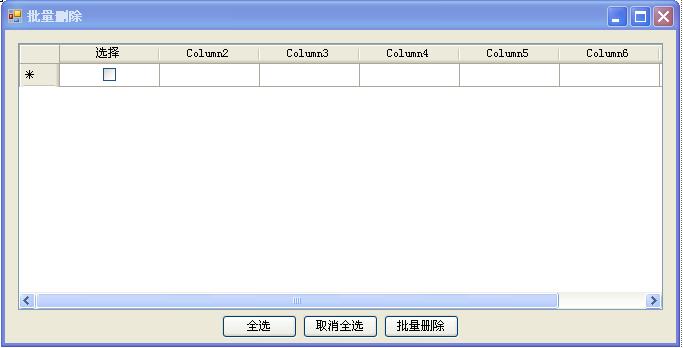dataGridView设计如下图:
代码如下:
using System;
using System.Collections.Generic;
using System.ComponentModel;
using System.Data;
using System.Data.SqlClient;
using System.Drawing;
using System.Text;
using System.Windows.Forms;
namespace test
{
public partial class Form1 : Form
{
public Form1()
{
InitializeComponent();
}
LinkDB linkdb = new LinkDB();
string strSelectAll = "select * from tb1";
string strTable = "tb1";
DataSet ds = new DataSet();
private void Form1_Load(object sender, EventArgs e)
{
dataGridView1.AutoGenerateColumns = false;
dataGridView1.AllowUserToAddRows = false;
dataGridView1.AlternatingRowsDefaultCellStyle.BackColor = Color.Azure;
ds = linkdb.QueryDB(strSelectAll, strTable);
dataGridView1.DataSource = ds;
dataGridView1.DataMember = strTable;
}
bool blIsSelectAll = false;
private void btnSelectAll_Click(object sender, EventArgs e)
{
//写法1
//if (dataGridView1.Rows.Count > 0)
//{
// for (int i = 0; i < dataGridView1.Rows.Count; i++)
// {
// dataGridView1[0, i].Value = true;
// }
//}
//blIsSelectAll = true;
//return;
//写法2
foreach (DataGridViewRow dr in dataGridView1.Rows)
{
((DataGridViewCheckBoxCell)dr.Cells[0]).Value = true;
}
blIsSelectAll = true;
return;
}
private void btnCancelAll_Click(object sender, EventArgs e)
{
foreach (DataGridViewRow dr in dataGridView1.Rows)
{
((DataGridViewCheckBoxCell)dr.Cells[0]).Value = false;
}
blIsSelectAll = false;
return;
}
private void btnDelete_Click(object sender, EventArgs e)
{
try
{
if (dataGridView1.Rows.Count > 0)
{
if (blIsSelectAll) //全选:进行批量删除
{
for (int rowIndex = 0; rowIndex < ds.Tables[strTable].Rows.Count; rowIndex++)
{
ds.Tables[strTable].Rows[rowIndex].Delete();//逻辑性删除(从数据集ds中删除)
//物理性删除(从DB中删除)
}
}
else //删除所选择的行
{
List<DataGridViewRow> tmpList = new List<DataGridViewRow>();
for (int j = 0; j < dataGridView1.Rows.Count; j++)
{
if (Convert.ToBoolean(dataGridView1[0, j].EditedFormattedValue.ToString()))
{
tmpList.Add(dataGridView1.Rows[j]);
}
}
for (int i = 0; i < tmpList.Count; i++)
{
dataGridView1.Rows.Remove(tmpList[i]);
}
tmpList = null;
}
}
}
catch (Exception ex)
{
MessageBox.Show(ex.Message);
}
}
private void dataGridView1_CellValueChanged(object sender, DataGridViewCellEventArgs e)
{
blIsSelectAll = false;
}
private void dataGridView1_RowPostPaint(object sender, DataGridViewRowPostPaintEventArgs e)
{
SolidBrush b = new SolidBrush(Color.Black);
e.Graphics.DrawString(Convert.ToString(e.RowIndex + 1), e.InheritedRowStyle.Font, b, e.RowBounds.X + 15, e.RowBounds.Y + 1);
}
}
}
using System.Collections.Generic;
using System.ComponentModel;
using System.Data;
using System.Data.SqlClient;
using System.Drawing;
using System.Text;
using System.Windows.Forms;
namespace test
{
public partial class Form1 : Form
{
public Form1()
{
InitializeComponent();
}
LinkDB linkdb = new LinkDB();
string strSelectAll = "select * from tb1";
string strTable = "tb1";
DataSet ds = new DataSet();
private void Form1_Load(object sender, EventArgs e)
{
dataGridView1.AutoGenerateColumns = false;
dataGridView1.AllowUserToAddRows = false;
dataGridView1.AlternatingRowsDefaultCellStyle.BackColor = Color.Azure;
ds = linkdb.QueryDB(strSelectAll, strTable);
dataGridView1.DataSource = ds;
dataGridView1.DataMember = strTable;
}
bool blIsSelectAll = false;
private void btnSelectAll_Click(object sender, EventArgs e)
{
//写法1
//if (dataGridView1.Rows.Count > 0)
//{
// for (int i = 0; i < dataGridView1.Rows.Count; i++)
// {
// dataGridView1[0, i].Value = true;
// }
//}
//blIsSelectAll = true;
//return;
//写法2
foreach (DataGridViewRow dr in dataGridView1.Rows)
{
((DataGridViewCheckBoxCell)dr.Cells[0]).Value = true;
}
blIsSelectAll = true;
return;
}
private void btnCancelAll_Click(object sender, EventArgs e)
{
foreach (DataGridViewRow dr in dataGridView1.Rows)
{
((DataGridViewCheckBoxCell)dr.Cells[0]).Value = false;
}
blIsSelectAll = false;
return;
}
private void btnDelete_Click(object sender, EventArgs e)
{
try
{
if (dataGridView1.Rows.Count > 0)
{
if (blIsSelectAll) //全选:进行批量删除
{
for (int rowIndex = 0; rowIndex < ds.Tables[strTable].Rows.Count; rowIndex++)
{
ds.Tables[strTable].Rows[rowIndex].Delete();//逻辑性删除(从数据集ds中删除)
//物理性删除(从DB中删除)
}
}
else //删除所选择的行
{
List<DataGridViewRow> tmpList = new List<DataGridViewRow>();
for (int j = 0; j < dataGridView1.Rows.Count; j++)
{
if (Convert.ToBoolean(dataGridView1[0, j].EditedFormattedValue.ToString()))
{
tmpList.Add(dataGridView1.Rows[j]);
}
}
for (int i = 0; i < tmpList.Count; i++)
{
dataGridView1.Rows.Remove(tmpList[i]);
}
tmpList = null;
}
}
}
catch (Exception ex)
{
MessageBox.Show(ex.Message);
}
}
private void dataGridView1_CellValueChanged(object sender, DataGridViewCellEventArgs e)
{
blIsSelectAll = false;
}
private void dataGridView1_RowPostPaint(object sender, DataGridViewRowPostPaintEventArgs e)
{
SolidBrush b = new SolidBrush(Color.Black);
e.Graphics.DrawString(Convert.ToString(e.RowIndex + 1), e.InheritedRowStyle.Font, b, e.RowBounds.X + 15, e.RowBounds.Y + 1);
}
}
}
